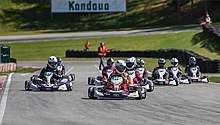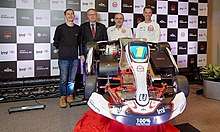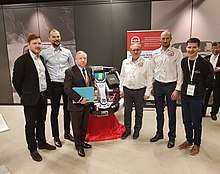Electric go-kart
An electric go-kart is a type of go-kart powered by electric motors and batteries, as opposed to traditional petrol engine. Electric go-karts are mostly intended for recreational usage, though high-performance models for a more serious kart racing are also offered.
Advantages / disadvantages
Advantages
Acceleration is usually better than conventional petrol engine karts and the speed is sufficient for use on most kart circuits. Torque in electric motors are usually greater than that of a petrol engine equivalent.
Electric go-karts are low maintenance, requiring only that the lead-acid batteries of the karts to be plugged into an array of chargers after each run. Since they are pollution-free and emit no smoke, the racetracks can be indoors in controlled environments. Most fully charged electric karts powered by lead-acid batteries can run a maximum of 30 minutes before performance is affected. An alternative is lithium polymer or lithium ion batteries, which last longer and offer higher performance.
Electric go-karts do not have fuel tanks or other flammable materials which can prove to be safer in case of an accident. However, batteries (especially lithium polymer batteries) can still catch fire or explode if severely damaged during such accident.
Disadvantages
Despite having a lower maintenance, electric go-karts often have higher operating and maintenance costs, as batteries and electric motors are typically more expensive than that of conventional engine, especially those powered by lithium batteries.
Electric go-karts powered by lead-acid batteries are low-powered and have a very short battery life; these go-karts can only run a maximum of 20 or 30 minutes before performance is affected, thus making it unsuitable for use in more serious racing. Because of this, a more expensive lithium batteries are commonly used for professional electric kart racing.

Racing
The ERDF Masters Kart racing event took place at the Paris-Bercy Arena in Paris, France in December 2011. Drivers from different auto racing series such as Formula 1, GP2 Series, WRC, DTM, IndyCar or kart racing got to compete with electric karts powered by a 40 hp brushless type electric motor.[1]
There are a few other events for electric karts such as e-Kart, a university challenge, also in France.
In the US, the Red Line Oil Karting Championship of Northern California started hosting in 2013 a field of Ekarts (Category V, Group 2, Class 1) competing for the Rattlesnake Electric Sport Championship.[2] Most weekends, lap times were within less than a second of the fastest laps, with a much better reliability than their gas cousins.[3]
In Canada, the G-Zero Championship Racing Series is set to start racing on temporary city street circuits in 2016.[4] The G-Zero series uses all-electric zero-emissions karts built by EVC Racing of Indianapolis IN featuring a blend of parts used in motorcycle racing and new innovative battery technology.[5]
France
Since 2006, an annual electric karting challenge is organized by associations and e-Kart.[6] This Challenge brings together manufacturers, schools, academic institutions (electrical engineering). This competition is played with machines expanding from 10 to 67 kilowatts, it takes place over three days and includes many tests (endurance 4 hours, best lap times, acceleration from stop over a distance of 50 meters, 10-minute races ...).
In 2013 the challenge has become international. It gathered 26 teams with 34 karts and 200 participants.[7] .[8]
Latvia, World's First
In 2015, Latvian company Blue Shock Race launched new technology type electric karts. BSR2017 Blue Shock Race kart is first kart in world, which have changeable battery with small, extremely effective lithium battery pack, with one charge can drive 10–15 min. BSR2017 kart is most competitive kart in rental kart sector right now.[9]
World's First National Electric Kart Championship[10]
In 2018 Latvia has become the first country in the World to officially hold the National Karting Championship for electric karts in classes TeK and TeK Open. The Championship kicked-off on May 1 on the historical Kandava go-kart track and during the season 6 rounds have been completed on different tracks in total. The Latvian Electric Kart Championship finals ended on the Jelgava track "Rulītis", where the winners of the Championship in the overall ranking were determined.

The first champion to take the gold medal was Ričards Irbe, who won 5 times in a row. The second place in the overall ranking belongs to Raivis Veiksans, who took the silver, while the third place and the bronze medal belongs to Raistis Plukss. 16 different racers from Latvia and Lithuania participated in the competition altogether.
In the Championship all the racers started off on electric kart powertrains made by Blue Shock Race, with a power output of 15 kW in Tek class and up to 25 kW power output in TeK Open class. During the Championship the best lap time was shown by Raivis Veiksans: 49.836 seconds.

The Championship was launched in partnership with the LMT Autosport Academy, which has been engaging in involving young people in motorsports for several years now. Thanks to the experience of the Academy and involvement of “-teen" technical schools in the Latvian Electric Kart Championship, it has become possible to gather 10 teams, which have worked hard on improving their equipment and have started off in the Championship. Blue Shock Race is a company that has been working with electric karts for 4 years already, developing this technology both in Latvia and throughout the World. Thanks to the Blue Shock Race experience, budget-friendly, technologically simple, and racing-friendly solutions have been created, allowing the racers to start off in the electric kart classes.
Since another World's Electric Kart Championship was launched in Germany on May 13, now both of these countries, Latvia and Germany, can be considered as pioneers when it comes to holding National Electric Kart Championships, and in fact, both countries deserve to bear the title of the First Championship. Currently Blue Shock Race is working on the development of new racing karts with a maximum output up to 55 kW with an ultimate racing capacity that can accelerate to 100 km/h in about 2,2 seconds, making this class an upper professional class.
In 2018 FIA and IOC have introduced Electric Karting as the first motorsport in the Youth Olympics and taking it to the 2024 Olympics in Paris, that's when the Blue Shock Race has set aim to go for the first Olympic Gold medals in the Electric Karting division.

After Latvian national electric kart championship stage 4 in Kandava Latvian company Blue Shock Race launched new electric sports kart for professionals. This kart are capable to compete with DD2 division karts. In Latvia have TeK Open class where is allowed to race with 25 kW karts and in 2019 will be more electric kart divisions.

See also
- Kart racing
- Electric kart racing
References
- (in French) Sodikart dévoile le SODI STX utilisé à Bercy – Kartelec, 6 December 2011
- Rattlesnake Electric Sport
- "Go-kart". whichgokartsforsale.com. Retrieved 19 April 2016.
- G-Zero Championship
- "EVC Racing". Archived from the original on 3 July 2013. Retrieved 28 January 2016.
- "Les challenges e-Kart". Archived from the original on 19 August 2017. Retrieved 29 January 2012.
- Les résultats de la Rencontre Pédagogique Internationale de Kart Electrique de Vierzon e-Kart 2013 - Site officiel e-Kart
- videos du challenge 2014 - Site officiel e-Kart
- http://blueshockrace.com
- http://blueshockrace.com
External links
- Rattlesnake – August 11 2012 Session 1 – EKart Test Session at Sonoma Raceway, YouTube